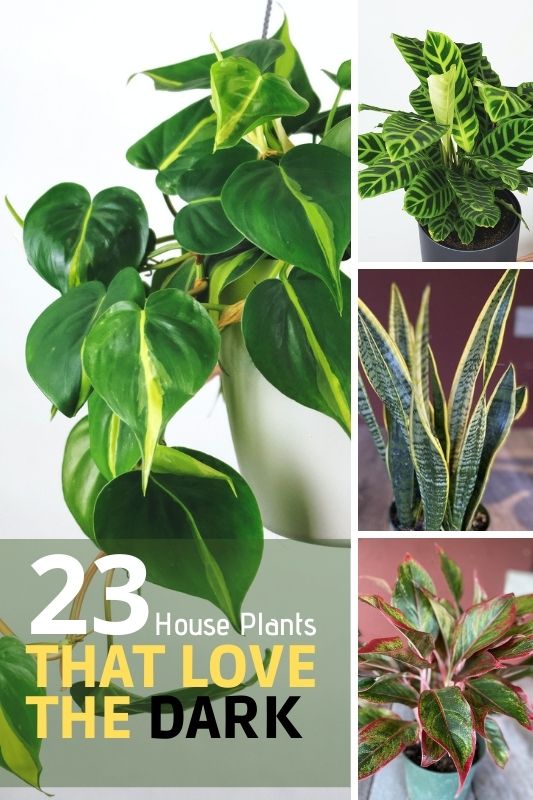
If you are looking for a plant that can grow in the darkest corner of your home, you definitely want to check out the following house plants. This list represents my top 23 plants that can grow in the (almost) dark.
While only parasitic plants can grow without any sunlight, all the other plants need at least a little bit of light. The plants that are listed below can easily survive for longer periods of time in low-light conditions. This makes them perfect for a dark and shady corner in your home or a dark office with only artificial lights.
Also, take into consideration, plants that are being kept in low light conditions might not grow but stay the same size. However, these plants won't decline either.
More details on how to care for low-light plants at the end of this list.
Contents
- House plants that grow in low-light conditions
- Dracaena 'Lemon Lime'
- Dracaena 'Janet Craig'
- Calathea elliptica 'Vittata'
- Begonia maculata
- Dumb Cane
- Syngonium macrophyllum
- Sansevieria zeylanica
- Pothos 'N joy'
- Cast Iron Plant
- Satin Pothos
- Dragon Plant
- Chinese Evergreen
- Sansevieria trifasciata
- Stromanthe 'TrioStar'
- Calathea lancifolia
- ZZ Plant
- Sansevieria cylindrica
- Red Prayer Plant
- Calathea ornata 'Beauty Star'
- Philodendron Brasil
- Spider plant
- Swiss Cheese Plant
- Calathea zebrina
- How to care for low-light plants?
House plants that grow in low-light conditions
Here is my top 23 plants that will grow in the (almost) dark.
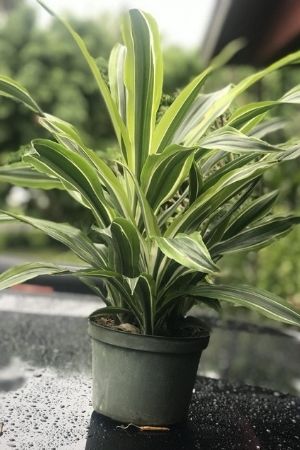
Dracaena 'Lemon Lime'
Dracaena Lemon Lime is an easy-to-care-for house plant that has long dark green leaves with light green outlines. The plant owes its name to the color of its leaves, which look like a lemon.
It's a small plant that can grow up to 2' (60 cm) tall and 15" (40 cm) in width.
The "Lemon Lime" is sensitive to root rot and doesn't need a lot of water. Only water when the top 1 to 2 inches of the soil are dry.
Image credits and plant seller: TropicalplantsFL.

Dracaena 'Janet Craig'
The "Janet Craig" will grow strongly upright and tends to drop its lower leaves as it gets older. It's a versatile plant that will look good with any kind of interior and needs very little light to grow. This makes the plant ideal for the darkest corner of the room.
It will grow about the same size as the Dracaena Lemon Lime and a big advantage of this Dracaena is that it is very good at air-purifying and removing toxic substances from the air.
The only downside of this plant is that it doesn't like cold drafts but that doesn't make it not worth buying.
Image credits and plant seller: TropicalplantsFL.
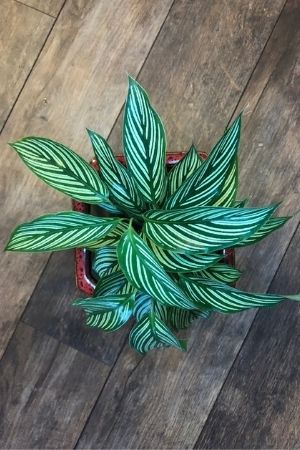
Calathea elliptica 'Vittata'
If you are looking for a highly-decorative house plant with colorful variegated leaves that will brighten up a dark living room or office, the Calathea family will do very well for you!
The Calathea elliptica "Vittata" has long, narrow leaves that are bright green with white "pinstripe" lines covering them.
Another great thing about the Calathea family is that they are all non-toxic to cats and dogs.
Image credits and plant seller: FancyPlantsyLLC.
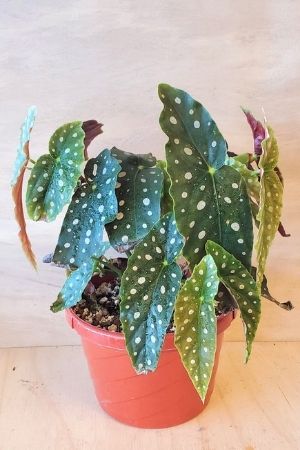
Begonia maculata
The Begonia maculata (or Polka Dot Plant) is native to the rainforests in Brazil and will make the perfect house plant for dark rooms.
Its popularity has risen a lot in the last 5 years which is not strange considering the plant is really easy to care for and has these unique-looking green to yellow leaves with white dots.
Be careful if you have pets or little children around this plant, because it can be toxic to them if they digest parts of the plant.
Image credits and plant seller: wishlistplant.
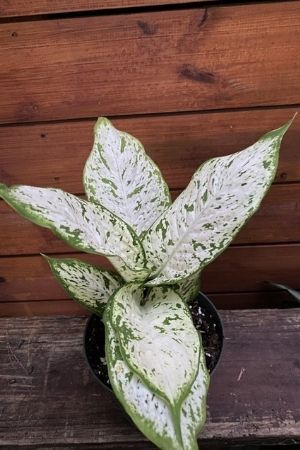
Dumb Cane
A strong and easy tropical house plant that will do great in dark places. This Dumb Cane plant (also known as Dieffenbachia Memoria Corsii) has almost completely white leaves with light green spots. The leaves stay the same year-round and the plant does not grow any flowers.
The Dumb Cane is native to Brazil and likes warm and humid places. It likes to be misted or sprayed twice a week.
Image credits and plant seller: TropicalplantsFL.
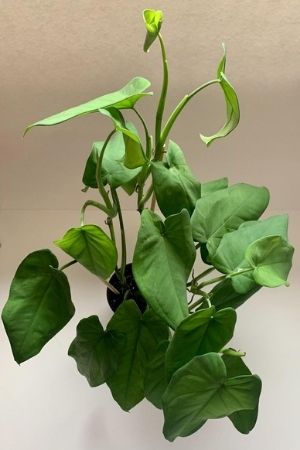
Syngonium macrophyllum
What makes this plant so unique is the color and texture of the foliage. The leaves have a leathery texture and a bright emerald green color which is quite unusual for the Syngonium.
Native to tropical areas from Mexico to Ecuador, this is a perfect house plant for beginners because it is hard to kill and will even thrive in a dark office or living room.
It will vine up to 10' (3 m) with leaves that can grow up to 8" (20 cm). If you want to know more about this plant, check out Syngonium macrophyllum care guide.
Image credits and plant seller: AtlanticBotanical.
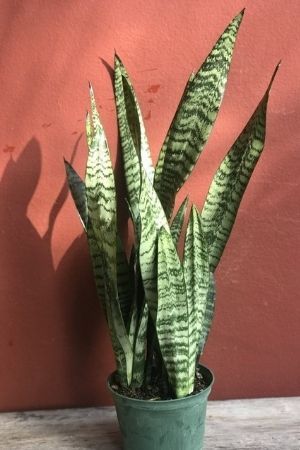
Sansevieria zeylanica
The Sansevieria zeylanica is a very strong, easy, and air-purifying plant that will grow long leaves up to 2.5 feet (75 cm) high and up to 1" (2.5 cm) in width. The leaves are light green with dark green zigzag lines and have a pointed tip. The leaves grow straight up and don't need to be supported because they are hard.
This is one of the easiest plants to care for and it doesn't require a lot of attention to grow. It also doesn't require any fertilizer and only needs to be repotted every 3 years.
Image credits and plant seller: TropicalplantsFL.

Pothos 'N joy'
The Epipremnum Aureum 'N Joy' (also known as the Pothos N Joy) is a beautiful variegated plant that can easily survive in a dark corner for a longer period of time. If you want to know all the care requirements for this plant, check out Pothos N Joy care-guide.
The Pothos N Joy is noted for its variegated heart-shaped leaves which are green in the middle with cream and white spots on the sides. The N Joy can trail up to 6.5 feet (2 m) long which makes this plant perfect for a dresser or shelf.
Image and plant seller: Wishlistplant.
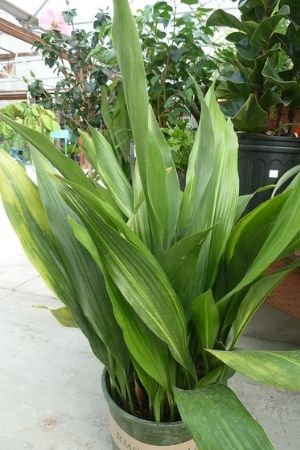
Cast Iron Plant
The aspidistra elatior (or Cast Iron plant) is the king of shadows. This elegant plant is an eyecatcher and also doesn't mind being in the darkest corner of your home.
It has long green leaves that will stay green throughout the whole year. It's mildly toxic to pets and humans and likes to be feed (with fertilizer) once a month during the spring and summer.
CC image by: NC State Extension Gardener.

Satin Pothos
Next is the Scindapsus pictus 'Argyraeus' (also known as the Satin Pothos). This dark-proof plant has highly decorative leaves that are gray-green. The Scindapsus pictus is a vining plant that does a great job at purifying the air and can trail up to 3 ft (90 cm).
If you keep this plant in the dark, it will most likely not grow 3 feet long, but it will keep the same size. However, it will still look good and thrive!
Check out the full care guide for Scindapsus pictus.
Image credits and plant seller: FancyPlantsyLLC.

Dragon Plant
The Dracaena marginata (also known as the Dragon plant) is a maintenance-friendly plant that can even withstand the DARK. It has strong (tree-like) stems and long small leaves that often have one or more light-green or yellow stripes over the entire length of the leaf.
The Dracaena is also known to be very efficient at cleansing the air of toxins which makes this plant the ideal house plant.
Image credits and plant seller: TropicalplantsFL.

Chinese Evergreen
The Aglaonema Red Siam Aura (or Chinese evergreen) definitely deserves a spot on this list. It's a plant that is known to easily withstand and grow the dark. The Chinese evergreen is extremely easy to grow as a house plant. It has eyecatching dark green leaves with red outlines which look absolutely stunning.
The dark-colored varieties of Aglaonema can grow in dark to low-light conditions while the lighter-colored varieties need more light.
Image credits and plant seller: TropicalplantsFL.

Sansevieria trifasciata
The Sansevieria trifasciata (or Snake Plant) has long sturdy leaves that are green with a yellow outline.
The Sansevieria family has a lot of different plants that will all do great in dark to low-light conditions!
Another great thing about this plant is that is it low-maintenance. Sansevieria plants prefer to have their soil dry out completely between waterings. You only have to water the plant once every 2-3 weeks!
Image credits and plant seller: TropicalplantsFL.
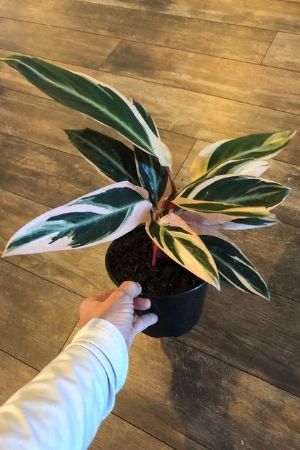
Stromanthe 'TrioStar'
Next, we have the Stromanthe Triostar, which is often mistaken to be a Calathea plant but it's actually a different species called Stromanthe sanguinea (or Prayer plant). It has very light colored leaves with different shades of green, pink on the topside, and dark purple on the bottom side.
Unfortunately, with all these bright colors, this plant won't GLOW in the dark but will definitely GROW in the dark!
Image credits and plant seller: FancyPlantsyLLC.
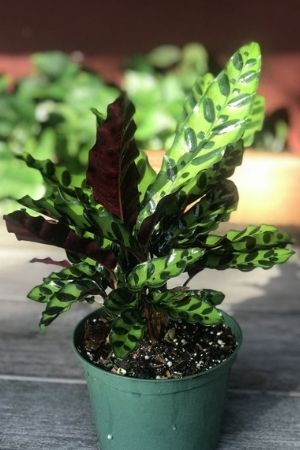
Calathea lancifolia
Love them or hate them, Calathea plants do very well in dark places. They are very strong and (in my opinion) look great!
The Calathea lancifolia (also known as the Rattlesnake Plant) has ribbed oval-shaped leaves that are light green with dark green spots on the topsides and dark purple on the undersides. This plant can grow up to 30" (76 cm) tall with leaves that can grow up to 18" (45 cm) long. Do you like this plant? Check out Calathea lancifolia Care Guide.
The leaves often fold up during the nighttime and then unfold during the day!
Image credits and plant seller: TropicalplantsFL.
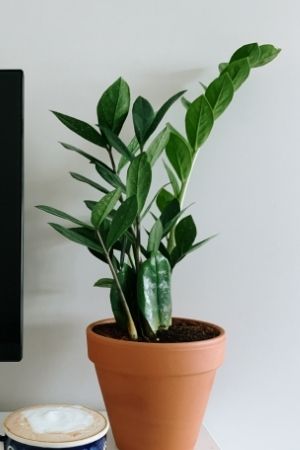
ZZ Plant
The Zamioculcas Zamiifolia (also known as the ZZ plant) should really be called the easy plant. An (almost) maintenance-free plant that will easily give your home a tropical vibe, even if there is almost no light.
The ZZ plant doesn't really care where you place him and he is rarely thirsty. Other plants are often jealous of the ZZ plant.
It is native to Eastern Africa and grows there on dry grassland and in forests. This stylish plant can grow up to 3 feet (90 cm) tall.

Sansevieria cylindrica
The Sansevieria Cylindrica (or cylindrical snake plant) is a very tough and easy plant that ENJOYS the dark. it's a plant that is getting more popular again and will look good with any interior design.
Did you know that the Sansevieria is named after the scientists who invented colored fireworks? Well, now you do!
Caution: the Sansevieria is slightly toxic. The toxins in the plant can cause stomach complaints in people and animals.
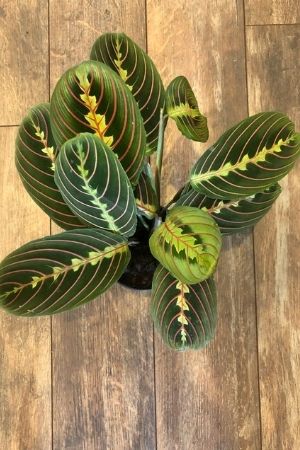
Red Prayer Plant
Another beautiful and dark-resilient plant on this list: the Maranta leuconeura (or Red Prayer plant). She has earned her nickname due to the fact that the leaves fold at night, resembling hands folded in prayer.
The Red Prayer plant is perfect for a hanging planter and if with only a small amount of light can grow up to 2 feet (60 cm) tall and 4 feet (1.2 m) wide.
Her magical leaf markings are very special and if she's feeling really good she can even bloom!
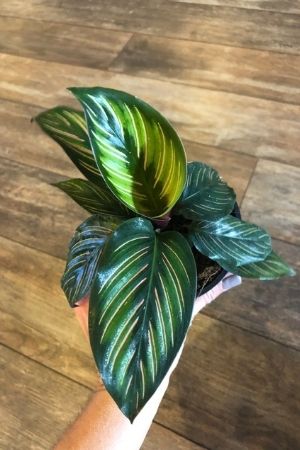
Calathea ornata 'Beauty Star'
This variety of the Calathea ornata, the Calathea ornata 'Beauty Star' (or Pinstripe Plant) is noted for its beautiful shaped green leaves that are striped in pink, white, and silver.
The Calathea houseplants are getting more and more popular, because seriously... Who doesn't want such a beautiful plant in their home? You can find a full care guide here: Calathea ornata ‘Beauty Star’ care.
Images by Ashley Reichwein from FancyPlantsyLLC.

Philodendron Brasil
On a quest to find the right low-light plant, the trailing Philodendrons are definitely worth checking out. The Philodendron Scandens 'Brasil' (or Philodendron Brasil) is variegated Philodendron leaves that are green with yellow stripes.
In the jungle the Philodendron Brasil likes to grow up against trees, so he is used to very little (direct) sunlight and he will be fine for longer periods of time in a dark corner of your home.
Because it's a relatively small plant, it is perfect for a bedroom or an office where it can be grown in either a hanging basket or on a shelf.

Spider plant
The Chlorophytum comosum (also known as spider plant) has long narrow leaves that are light green in the middle and have dark green stripes on the side. Because this plant is already a slow grower, placing it in low-light conditions might slow growth even more. However, this plant is very good at adapting to lower light situations. Spider Plants also prefer their soil to dry out between waterings.
According to NASA, this plant is very good at removing harmful substances like benzene, formaldehyde, and carbon monoxide from the air.
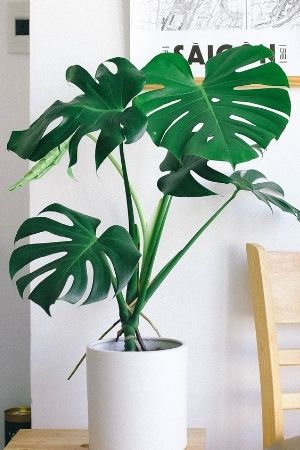
Swiss Cheese Plant
If you don't know this plant by now, you have probably been living under a rock! The Monstera deliciosa (or Swiss Cheese Plant) is a very popular plant, and with a good reason, because this plant looks absolutely gorgeous. It's a tropical plant that is easy to care for and will effortlessly thrive in low-light or with only artificial lights. This makes the Monstera deliciosa perfect for an office or a room without (big) windows.
It can tolerate long periods of low light but ultimately wants to have bright indirect sunlight. Only water once a week, when the top inch of the soil feels dry.

Calathea zebrina
Last but not least, the Calathea zebrina (also known as the Zebra Plant). It is noted for its unique painted foliage that has a zebra print (which is how it got its nickname). New leaves will first appear yellow and slowly unfurl when the leaves mature.
This plant will do perfectly in low-light conditions and LOVES a higher humidity making this a perfect plant for a bathroom. The Zebra plant really likes to get misted or sprayed with water 2-3 times a week. If you want to know everything about this plant, check out Calathea zebrina Care Guide.
How to care for low-light plants?
Caring for low-light plants is generally pretty easy because these plants are all very tough and hard to kill. They only need a little bit of light and water.
How much water they need depends on the kind of plant. While, for example, the Philodendron Brasil and the Sansevieria plants like to have their soil dry out between waterings, the Red Prayer Plant likes to have consistently moist soil.
Please note that when plants receive less light, they automatically need less water. Check the soil by touching the top part of the soil with your fingers before watering again.


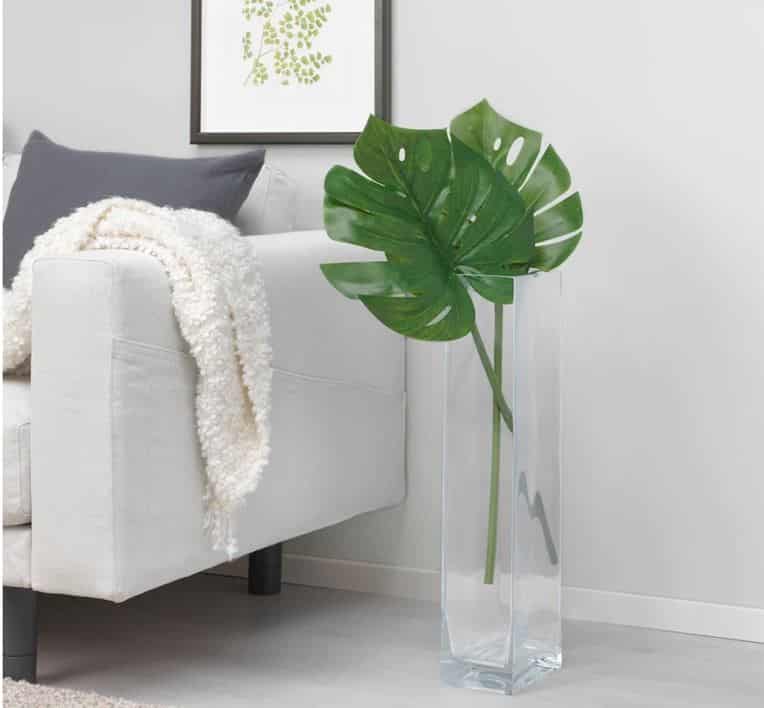
Leave a Reply